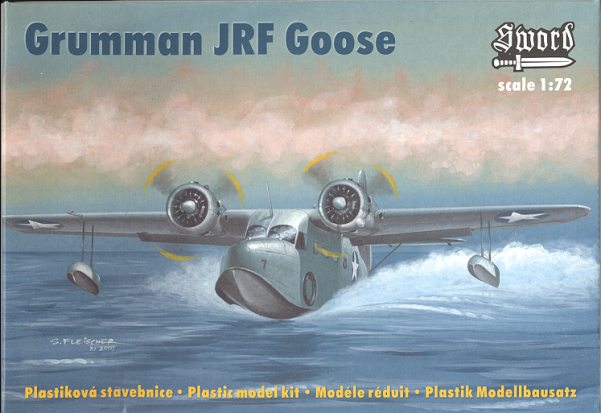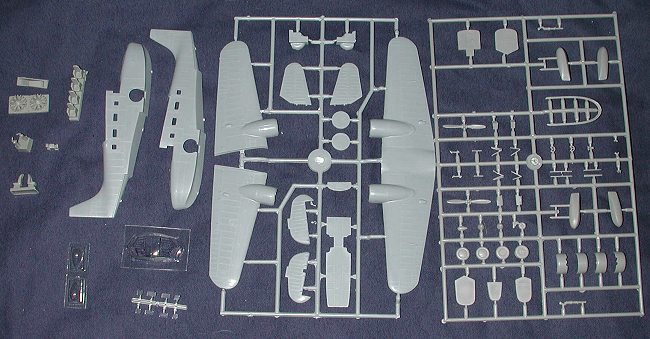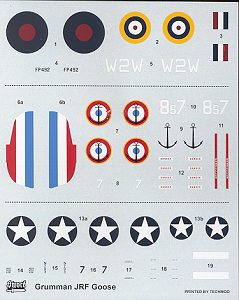
|
KIT: |
Sword 1/72 JRF Goose |
|
KIT # |
72011 |
|
PRICE: |
$ |
|
DECALS: |
Three aircraft |
|
REVIEWER: |
|
|
NOTES: |
Short run with vac canopy and resin parts |

|
HISTORY |
Grumman's model G-21 first flew in 1937 and was the basis for a number of military variants including the OA-9 and the JRF. First delivered to the USAAC in 1938, the Navy's versions were delivered the next year followed by those for the Coast Guard. Initial deliveries were only a handful of aircraft, but with the war looming, more were ordered with several hundred finally being delivered. In addition to the US, aircraft were ordered by and delivered to the British, French and many other countries.
Designed more as a utility transport, it had little in the way of offensive armament, though some which performed coastal patrol duties were fitted with wing racks for 250 lb depth bombs. Even after the war the plane saw continued use, though mostly with non-US air arms and several are still flying today. Personally, I wish this kit had been released about 10-15 years ago. There was a short-lived television show called "Tales of the Gold Monkey" which prominently featured the Goose. It will be interesting to see if any aftermarket decal makers will include 'Cutter's Goose' to the repertoire of markings on their sheet.
|
THE KIT |

'Typical Czech short run, yada yada yada....'. Sword is not one of the MPM companies, but is similar in many ways. This one has resin parts (though dark grey and not tan) for the engines, seats, and exhaust. It also has two vac canopies, though the cabin windows are injected plastic. The kit plastic itself feels a touch rough with the engraving a bit more coarse than on an MPM kit. There is a small amount of flash on some of the parts, and some of the smaller and thinner bits are on the verge of being broken. With largish sprue gates, a razor saw it recommended for these little bits and care will be needed to prevent more damage. The big pieces have ejector stubs that will need removed. I saw no other ejector pin marks or any sink marks on the other parts.
The upper wing is a single piece which will help a great deal when it comes time
to build the wing. Tail planes have small indentations to help fit. One of them
was filled on my example so will need drilled out. There are also very shallow
indentations on the lower wing to assist with placement of the wing floats. The
forward fuselage chine is a single piece and
 looks as if it will be a bit of a
challenge to get properly situated and attached. I'd be surprised if all went
smoothly with this piece!
looks as if it will be a bit of a
challenge to get properly situated and attached. I'd be surprised if all went
smoothly with this piece!
Instructions are quite good and in addition to the usual construction diagrams, includes several 'info' diagrams showing proper alignment of some of the more complicated parts such as the landing gear. Though no diagrams are given showing a wheels up build, I'd think it would be a pretty simple thing to do. Markings are given for three planes: one from the US in what is listed as medium sea grey over light sea grey; one RAF in Extra Dark Sea Grey/Dark Slate Grey over Sky; and one French in overall sea blue. Decals are by Techmod. They are glossy and crisply printed. One of my French roundels was badly marred, undoubtedly due to scraping against something during shipping. If you don't like any of these schemes, they I'm sure you could cobble something together from your spare decals bin as the plane was used by a variety of different countries.
|
CONCLUSIONS |
It is thanks to the Czechs that we have models of interesting aircraft like this. I just can't see Airfix or Italeri spending the money to do a mold of an aircraft like this. It seems to be a pretty normal build for those who have some experience with short run kits and should make into a very nice model when done.
Review kit courtesy of my kit collection.
If you would like your product reviewed fairly and quickly by a site that has well over 100,000 visitors a month, please contact me or see other details in the Note to Contributors.